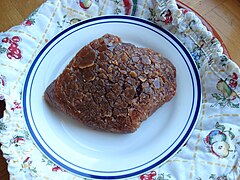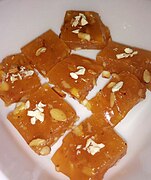Cookbook:Halva
Cookbook | Recipes | Ingredients | Equipment | Techniques | Cookbook Disambiguation Pages

Halva, also called halwa, halveh, and other variations, is a type of confection originating in Persian/Iranian cuisine that has since become widespread across western Asia, eastern Europe, and parts of the Mediterranean.
History
[edit | edit source]The roots of halva go back to Persian cuisine, and the name is derived from the Arabic root meaning "sweet". Around the 9th century, the term referred to a Persian confection of cooked wheat flour paste with a sweetener kneaded in and various flavorings and fillings added—this variety still exists today.
Types
[edit | edit source]Generally speaking, halva can be divided into three main types:
- Cooked, flour-based;
- Ground nut/seed-based; and
- Fruit/vegetable paste-based; or
- A combination of the aforementioned.
South Asia
[edit | edit source]Halva is popular and diversified in the Indian subcontinent, where it can be made of grain/flour or a variety of fruit and vegetable pastes. To make the grain-based variety, a ground grain product or flour (such as semolina, zedoary, or legumes) is typically cooked in ghee, after which a syrup is kneaded in and additional spices and ingredients are incorporated. Other varieties rely on sweetened fruit or vegetable pastes. All of these varieties can incorporate a wide range of ingredients, including but not limited to:
- Carrot
- Potato
- Beet
- Squash
- Yam
- Lentil
- Peanut
- Milk curds
- Coconut
- Semolina
- Coconut
- Nuts
- Saffron
- Cinnamon
- Cardamom
- Nutmeg
- Papaya
- Banana
- etc.
In Pakistan, Karachi halva is make from cornstarch, ghee, and sugar syrup.
Western Asia
[edit | edit source]Sesame halva is popular in Western Asia, made of ground sesame seeds mixed with a sugar syrup and shaped into cakes. It is perhaps the most well-known halva variety in North America. Semolina halva is also popular in Western Asia, and both types are often supplemented with nuts and dried fruits. In Iraq, halawah bil loz is a variety of almond halva similar to marzipan, and halawat tamr is a mixture of chopped dates, almonds, and walnuts. In Iran, the variety of halva is so great that many varieties are still unknown.
Gallery
[edit | edit source]-
Pistachio halvah
-
Semolina halva, cut into diamonds
-
Assorted Indian halva
-
Nepali halwa
-
Somali halwo
-
Turkish sesame halva
-
Indian atte ka halva
-
Karachi cornstarch halva
-
Greek Farsala halva
Recipes
[edit | edit source]External links and sources
[edit | edit source]- https://www.google.com/books/edition/The_Oxford_Companion_to_Food/bIIeBQAAQBAJ?hl=en&gbpv=1&pg=PA378&printsec=frontcover
- https://www.google.com/books/edition/Encyclopedia_of_Jewish_Food/gFK_yx7Ps7cC?hl=en&gbpv=1&pg=PT772&printsec=frontcover
- https://archive.org/details/worldofjewishcoo00mark/page/209/mode/2up
- https://www.nytimes.com/2004/03/24/dining/for-halvah-use-1-2-cup-nostalgia.html
- https://www.delightedcooking.com/what-is-halva.htm
- https://www.myjewishlearning.com/recipe/israeli-halvah/









